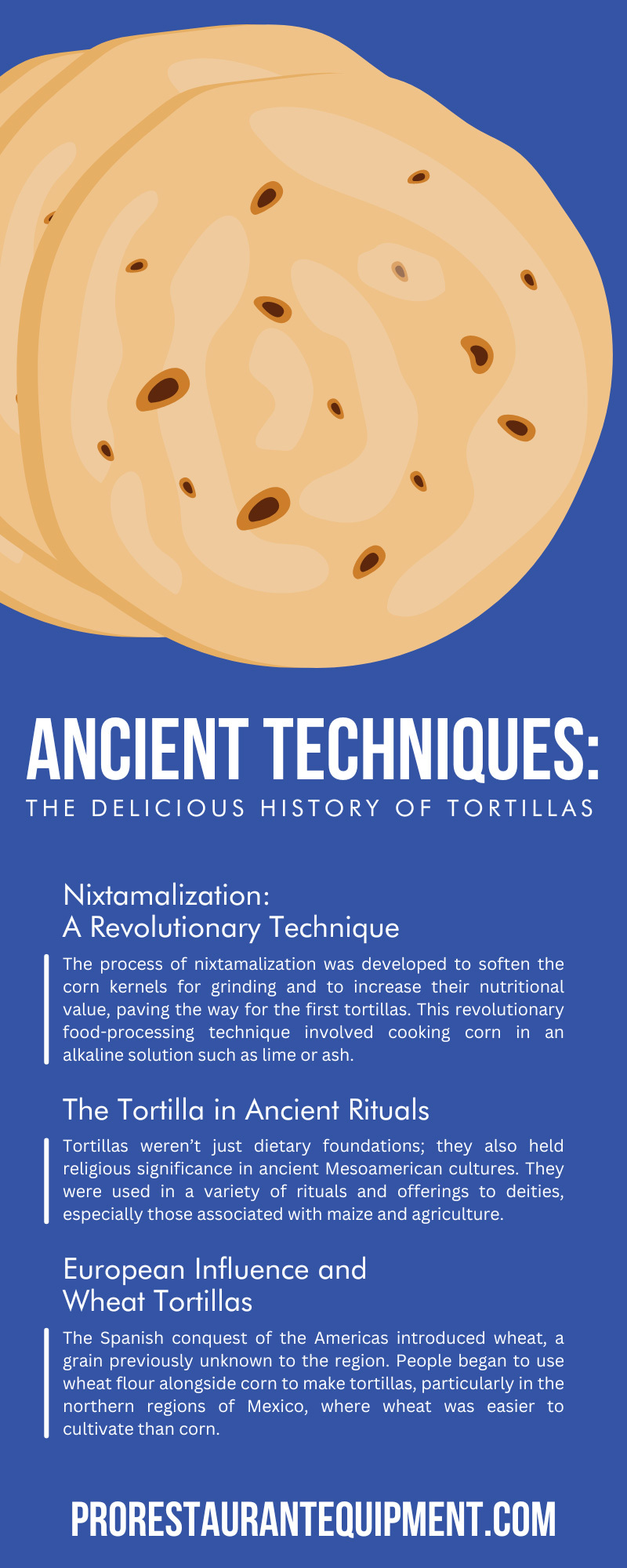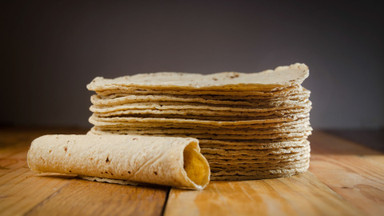May 13th 2024
Ancient Techniques: The Delicious History of Tortillas
The delicious history of the tortilla dates back over 10,000 years, originating with the indigenous peoples of Mesoamerica, a region that includes modern-day Mexico and Central America. Corn, also known as maize, was not only a staple food but also a cultural symbol. Today, tortillas are more than just staples in Mexican cuisine—they’re cultural artifacts that have nourished countless generations.
From their ancient origins to modern-day innovations, the history of tortillas is as rich and complex as the flavors they enhance in dishes worldwide. Read on to learn all about the tortilla and its delectable history.
Nixtamalization: A Revolutionary Technique
The process of nixtamalization was developed to soften the corn kernels for grinding and to increase their nutritional value, paving the way for the first tortillas. This revolutionary food-processing technique involved cooking corn in an alkaline solution such as lime or ash. This process broke down the hard outer shell, or pericarp, of the maize, making the maize more palatable and easier to grind. More importantly, it released niacin, a vital nutrient, and made the maize digestible, preventing diseases such as pellagra and boosting the maize’s overall nutritional profile. This technique allowed ancient civilizations to thrive on a diet based primarily on corn.
The Tortilla in Ancient Rituals
Tortillas weren’t just dietary foundations; they also held religious significance in ancient Mesoamerican cultures. They were used in a variety of rituals and offerings to deities, especially those associated with maize and agriculture. The tortilla’s round shape and flat nature were symbolic, often linked to the sun and the Earth in these cultures.
European Influence and Wheat Tortillas
The Spanish conquest of the Americas introduced wheat, a grain previously unknown to the region. People began to use wheat flour alongside corn to make tortillas, particularly in the northern regions of Mexico, where wheat was easier to cultivate than corn. This adaptation led to the creation of the flour tortilla, which has become a staple in its own right, especially in Tex-Mex and other global cuisines.
Regional Variations
As tortillas spread throughout Mexico and beyond, various regional variations developed. In Oaxaca, the tlayuda, a large, crispy tortilla, is popular, while in Sonora, tortillas are often very large and made with wheat flour. Each region has put its unique spin on the tortilla, showing the versatility and adaptability of this simple food.
The Industrialization of Tortilla-Making
The Industrial Revolution brought mechanization to tortilla-making during the 20th century. The introduction of motorized presses and tortilla-making machines allowed for mass production of tortillas, making them more affordable and widely available. This was a significant shift from the traditional hand-pressing methods that people had used for centuries.
The Tortilla Today
Today, you can find tortillas worldwide. They’re integral to various international cuisines, not just Mexican. They’re used in everything from traditional tacos and enchiladas to fusion dishes such as tortilla pizzas and wraps, showcasing their global culinary influence.
Nutritional Value
Tortillas provide essential nutrients such as fiber, vitamins, and minerals. They’re low-fat sources of carbohydrates, making them healthy choices, especially when made from whole grains and without added fats.
Dietary Adaptations
Innovation in tortilla production continues to grow as manufacturers seek to meet consumer demand for healthier, more diverse options. This includes the development of tortillas with enhanced nutritional profiles, such as added protein, omega-3 fatty acids, or fiber. Producers are also experimenting with alternative grains such as blue corn, quinoa, and even cauliflower to cater to gluten-free and low-carb diets. Tortilla varieties now include low-carb, gluten-free, and whole-wheat options, providing alternatives for people with dietary restrictions or who are seeking healthier options.
Additionally, advancements in packaging technology extend the shelf life of tortillas without the need for preservatives, maintaining freshness and reducing food waste.
Tortillas in Popular Culture
Tortillas have transcended their culinary role, appearing in popular culture and becoming synonymous with Mexican food globally. They’re celebrated through festivals and culinary competitions, and they have even made their way into space as part of astronauts’ meals, proving their versatility and universal appeal.
The Art of Tortilla-Making
Tortilla-making is an age-old craft revered in many cultures, primarily Mexican. The traditional process involves mixing masa harina (dried corn dough) with water to form a pliable dough. Skilled hands then pat the dough into thin, round disks, which are cooked on a hot comal (griddle) until they puff up slightly, which indicates they’re ready. This method has been passed down through generations and is celebrated not only for the delicious product but also for preserving this cultural heritage. Today, machines can replicate this process on a larger scale, but handmade tortillas are still highly prized for their authenticity and flavor.
Tortilla Festivals
Tortilla festivals serve as vibrant celebrations of the tortilla’s cultural significance and culinary versatility. Popular in regions of Mexico and the southwestern United States, these events feature tortilla-making contests, cooking demonstrations, and recipe exchanges, showcasing traditional and innovative tortilla-based dishes. Participants of all ages engage in activities that celebrate the tortilla’s role in local gastronomy, such as “biggest tortilla” competitions or “fastest tortilla-making” challenges. These festivals not only honor culinary traditions but also foster community spirit and appreciation for this staple food.
The Role of Tortilla-Making Machines
In the modern culinary landscape, tortilla-maker machines play a crucial role by ensuring efficiency and consistency in tortilla production. These machines range from small countertop devices suitable for restaurants to large industrial machines designed for mass production. A tortilla-making machine typically presses the dough into perfect circles and cooks it uniformly, producing a high volume of product without sacrificing quality. This technology allows manufacturers to keep up with high demand while freeing up human labor for more creative culinary tasks, thus blending tradition with modern efficiency.
Now that you know the deep-rooted, delicious history of tortillas, from ancient techniques to modern innovations, you can appreciate why this beloved food item remains a staple in traditional and contemporary cuisines. Embracing conventional methods along with modern advancements ensures the tortilla will continue to be celebrated and enjoyed for generations to come.


